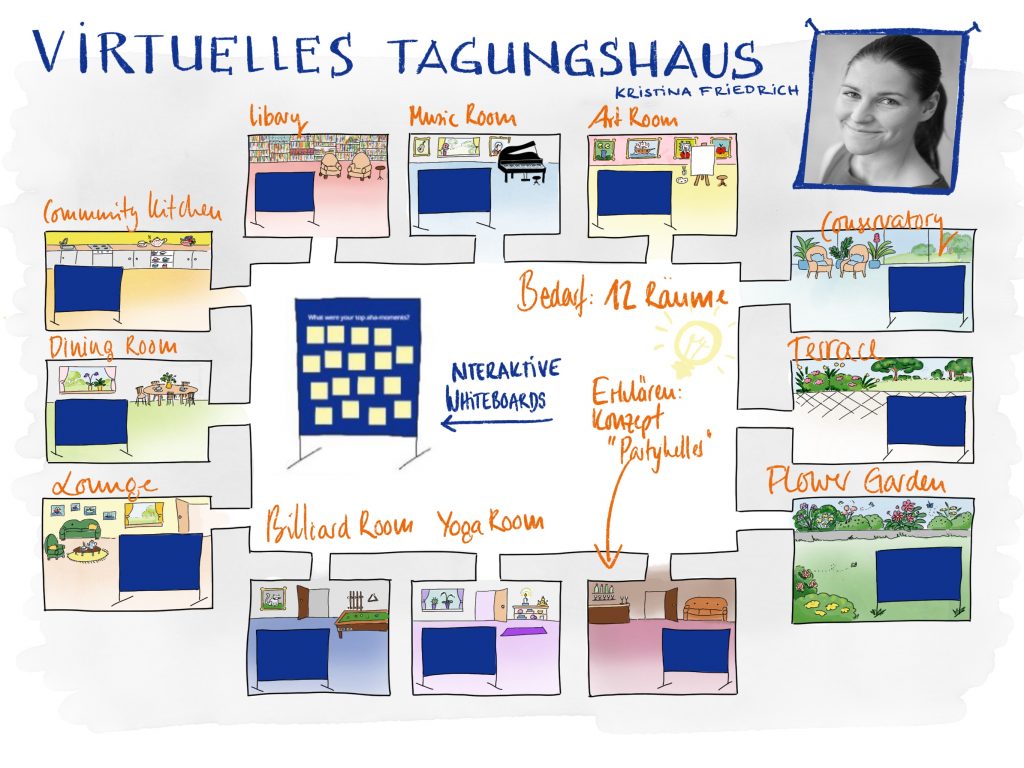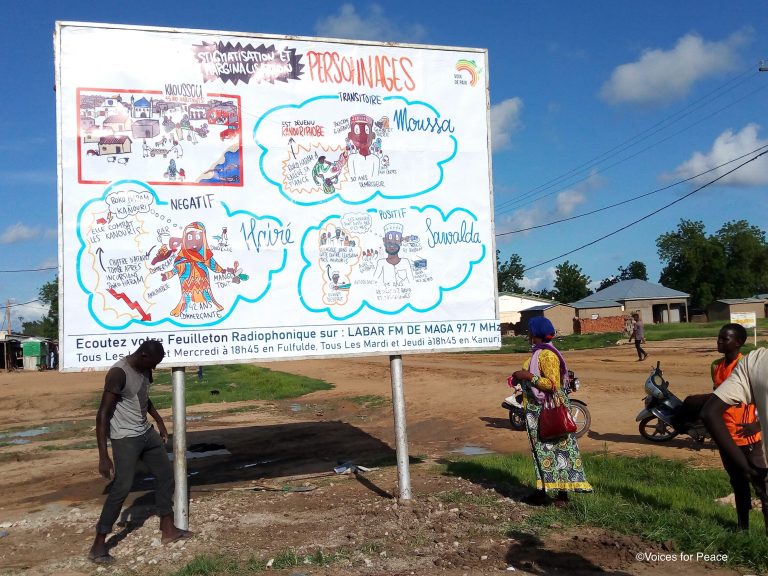“Can We Have the Key to the Party Room?”
“… we still have something to talk about!” This request came in to facilitator Kristina Friedrich, (from the ECB) after she created a template that represented a house for a breakout session for 60 people at a virtual conference. The visual was hand drawn, not a fancy 3D animation. The design of this experience filled two voids that we typically experience working online: the feeling of being physically together and the inability to have real-time dialogue. The session was so engaging that people continued to talk even after working hours – in the party room, that is.
In this interview, Kristina shares what this picture is all about and how the methods she learned from the bikablo training “Presence meets online” were helpful in designing this session.
by Susann Figueredo Hechavarria
SHARE ARTICLE
Dear Kristina, you shared an image in the Essentials training that everyone really liked: a virtual meeting house. Tell us about that visual.
I was responsible for facilitating a conference with the Information and Knowledge Management department. It was about finding a common path and identity for the department. We used the Miro tool, which we technically mastered, but it did not provide space for social connection or a place to share our emotions. We felt these were very important elements to consider when working on identity issues. Then, in the third module of the bikablo Online Essentials course, “Collaboration Tools”, I learned about the idea of drawn spaces from Frank Wesseler. That was a great discovery for me. Naming workspaces after different types of rooms in a house, (especially ones that might not always be visited) is a simple, but very effective tool.I could tell that it was effective by the fact that there was still a lively chat after work hours. I would hear questions like, “Where were you today and with whom?”. And the response, “Oh, in the billiard room, I want to go there too….”

How do you explain this effect?
People are used to formal settings in work conversations. Using the theme of a house and its different rooms, helps people feel more relaxed as it feels more like a gathering than a formal work meeting. By having different types of rooms, you create the idea of distinct spaces, which might have different moods or purposes. Since exchanges are less formal, it evokes a different type of response from participants, which makes it more emotional and collaborative. For example, the idea of the party cellar is obviously a German one. Since we work in a European context, we first had to explain the term “party cellar,” which has already caused great hilarity.When people then virtually enter a workspace from which they expect entertainment, internationality and casual get-togethers, this has a positive effect on the subsequent dialog. I would say , “You don’t just get pigeonholed into a space”.
How prepared were you for remote work in your job?
Quite well. As an ECB, we are well prepared for disasters, and we were able to continue working virtually right away from our home offices. And that’s where all of us have been for over a year now. In that respect, I would say we are well equipped. However, something is often missing, which is connecting emotionally, real-time collaboration and creative inspiration.
How did you come across our Online Essentials course, and to whom would you recommend it to?
I have been a bikablo customer and professional colleague for many years, so when I heard about this new offer, I decided it was a fit. I have engaged in professional development to learn techniques to effectively facilitate content online, however I felt I could still use more in-depth knowledge of online delivery techniques with a flavor of bikablo. In “bikablo online essentials”, (previously known as “presence meets online”) I had the opportunity to learn from different experts in the areas of facilitation, technology and visualization and walked away with a lot of rich learning from each module. Many of the module concepts in the course are broad, but there are nuggets of wisdom in each that help you shift your thinking and help you deepen your understanding of ideas and concepts you may think you already know.
Unlike other bikablo training where you have the same group for the full training, the intimate nature and length of this program makes that model very challenging. Therefore, the training has been redesigned into six modules that are now available as half-day courses. The modules can be booked individually, so you may not have the same participants in your group for every session, but it provides more freedom for people to choose which topics are relevant to them.
What stays the same in this training is the value of the individual perspective where we want to hear each person’s unique point of view which requires space for conversation. We also value learning with all senses, even with online collaboration.
All the facilitators of this course have extensive experience applying the material they teach, and can provide context for when different tools and methods could be used, common challenges and tips to make your online collaborations successful. I would therefore recommend it to anyone who already has previous experience but wants to improve it, who wants to be inspired without expecting a typical “all-round training”. I would also recommend it to anyone who wants to bring more emotion, spontaneity and diversity into their events.
Dear Kristina, thank you very much for providing insights into your work and showing us how you implemented what you learned and created meaningful spaces for meetings!
MORE ARTICLES ON THIS TOPIC
You Might Also Be Interested In...

Using pictures to promote a good climate: bikablo meets Fridays For Future
With “Fridays for Future” a fascinating worldwide youth movement has emerged. bikablo supported the summer congress in Dortmund with graphic recording and visualization trainings.

Closer than we thought: Visualization and Comics
What do graphic novels and graphic recording have in common? This is the question bikablo asked itself in a conversation with the comic artist Oliver Scheibler at the Comic Festival in Cologne. An experience report with surprising insights.

How to create an educational radio soap with a pencil
Interview with visualizer Filippo Buzzini of ‘Sketchy Solutions’, who helped us with a project in West Africa.